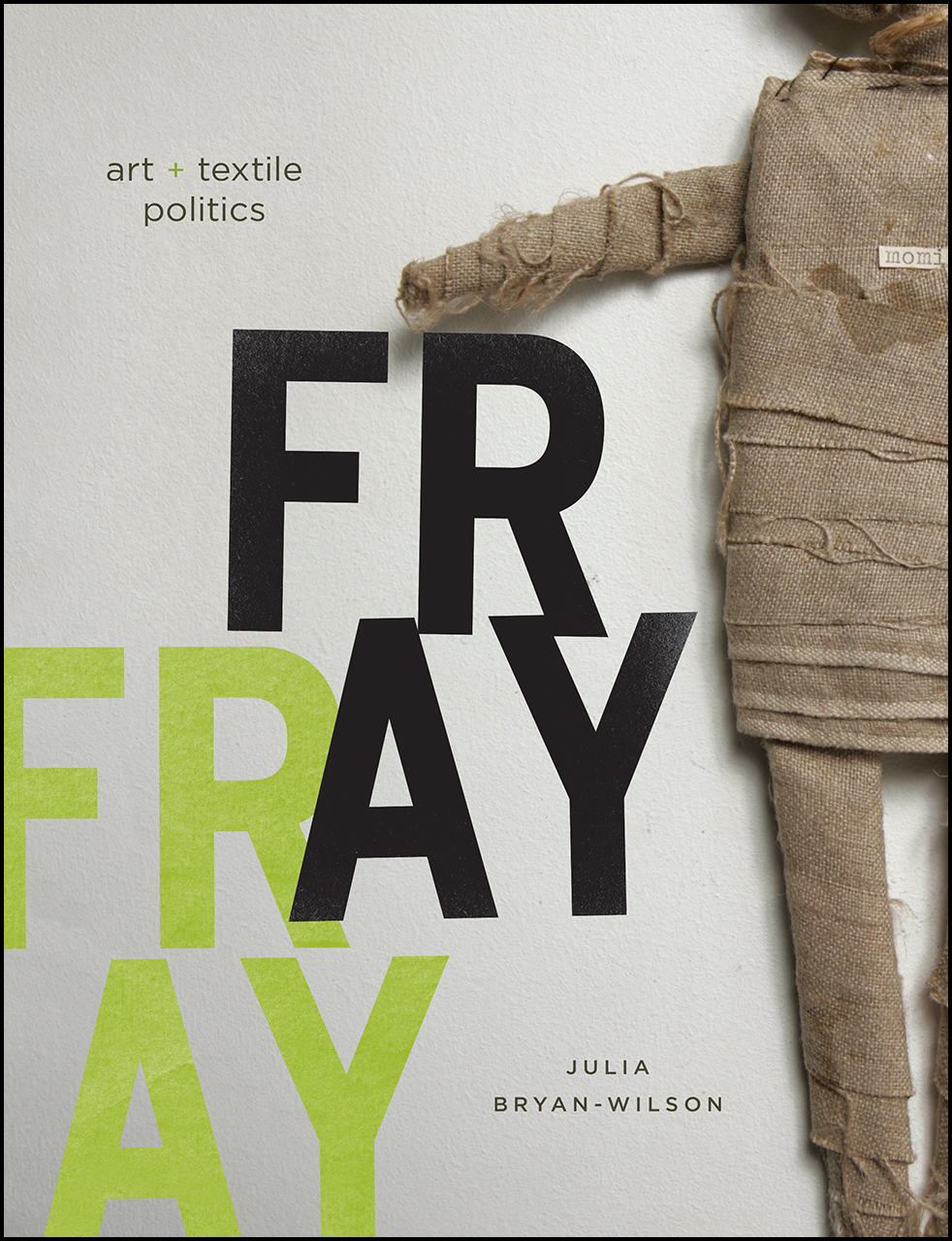Julia Bryan-Wilson: Fray: Art and Textile Politics (2017)
Filed under book | Tags: · activism, aids, art, art criticism, art history, craft, feminism, fiberwork, folk art, gender, handmaking, labour, politics, queer, quilting, race, textile, textile design, weaving

“In 1974, women in a feminist consciousness-raising group in Eugene, Oregon, formed a mock organization called the Ladies Sewing Circle and Terrorist Society. Emblazoning its logo onto t-shirts, the group wryly envisioned female collective textile making as a practice that could upend conventions, threaten state structures, and wreak political havoc. Elaborating on this example as a prehistory to the more recent phenomenon of “craftivism”—the politics and social practices associated with handmaking—Fray explores textiles and their role at the forefront of debates about process, materiality, gender, and race in times of economic upheaval.
Closely examining how amateurs and fine artists in the United States and Chile turned to sewing, braiding, knotting, and quilting amid the rise of global manufacturing, Julia Bryan-Wilson argues that textiles unravel the high/low divide and urges us to think flexibly about what the politics of textiles might be. Her case studies from the 1970s through the 1990s—including the improvised costumes of the theater troupe the Cockettes, the braided rag rugs of US artist Harmony Hammond, the thread-based sculptures of Chilean artist Cecilia Vicuña, the small hand-sewn tapestries depicting Pinochet’s torture, and the NAMES Project AIDS Memorial Quilt—are often taken as evidence of the inherently progressive nature of handcrafted textiles. Fray, however, shows that such methods are recruited to often ambivalent ends, leaving textiles very much “in the fray” of debates about feminized labor, protest cultures, and queer identities; the malleability of cloth and fiber means that textiles can be activated, or stretched, in many ideological directions.
The first contemporary art history book to discuss both fine art and amateur registers of handmaking at such an expansive scale, Fray unveils crucial insights into how textiles inhabit the broad space between artistic and political poles—high and low, untrained and highly skilled, conformist and disobedient, craft and art.”
Publisher University of Chicago Press, 2017
ISBN 9780226077819, 0226077810
326 pages
via slowrotation
Reviews: Holland Cotter (New York Times, 2017), Barbara Wisnoski (J Canadian Art History, 2018), Alexa Griffith Winton (J Design History, 2019), Janis Jefferies (Art Bulletin, 2019), Elizabeth S. Hawley (Winterthur Portfolio, 2019), Jayme Collins (InVisible Culture, 2019), Jason Edwards (Sculpture J, 2019), Katarzyna Falęcka (J Visual Culture, 2021).
Video interview with author (with Lynne Cooke, NGA, 60 min, 2017)
PDF (18 MB)
Comment (0)Anni Albers: On Weaving (1965–)
Filed under book | Tags: · art, bauhaus, design, weaving

“In this book, Anni Albers develops the thoughts on the history and design of weaving which she put forward in her collection of essays On Designing, published in 1959. Although On Weaving is not meant to be a technical reference book, it conveys a fundamental understanding and appreciation of the craft, both to the textile expert and to the interested layman, and is written in uncomplicated language, illustrated with clear diagrams.
In chapter 5 Anni Albers says: ‘Though elaborations are usually thought to be an advance of stage of work, they are often an easy expansion from basic concepts. Intricacy and complexity are not, in my mind, high developments. Simplicity, rather, which is condensation, is the aim and the goal for which we should be heading. Simplicity is not simpleness but clarified vision–the reverse of the popular estimate.’
This methodically intellectual approach has been applied in the composition and writing of this book and has enabled the author with her expert knowledge to condense into a small space the very quintessence of designing woven fabrics and the many facets and intricacies of this craft. But at the same time Anni Albers is able to excite and inspire the reader’s imagination and unravel the romantic story of weaving.
The technical side, which includes tapestry and carpet weaving, weaves and their derivatives, cloth constructions and materials is extremely well documented with drawings and photographs. The artist-designer will find delight in the many illustrations of ancient and modern weaving.” (back cover)
First published by Wesleyan University Press, Middletown/CT, 1965
Reprint, Studio Vista, London, 1974
ISBN 0289370043
204 pages
via x
Review: Irene Emery (American Anthropologist, 1968).
PDF (1965/1974, 30 MB, no OCR)
HTML (New Expanded Edition, 2017, added on 2017-10-30)

